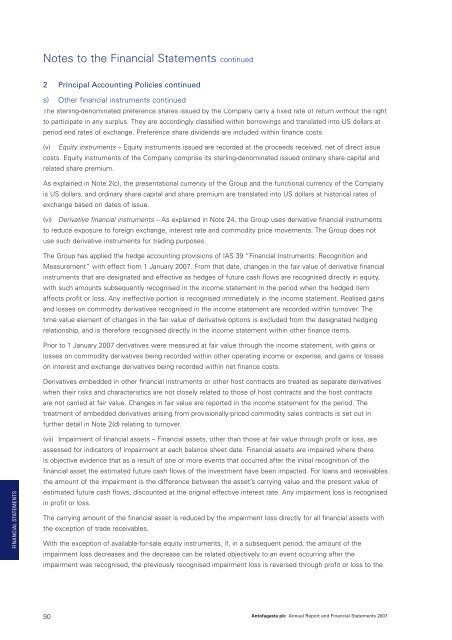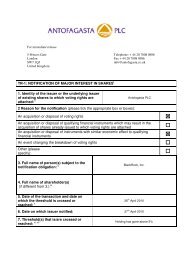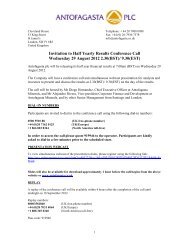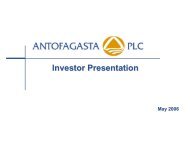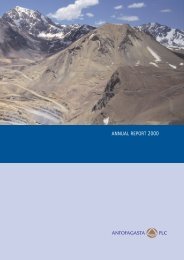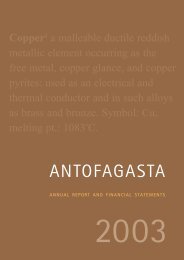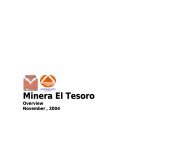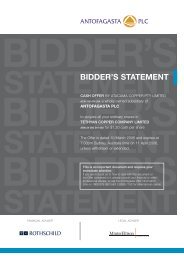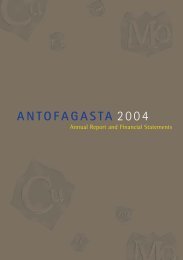Annual Report 2007 - Antofagasta plc
Annual Report 2007 - Antofagasta plc
Annual Report 2007 - Antofagasta plc
You also want an ePaper? Increase the reach of your titles
YUMPU automatically turns print PDFs into web optimized ePapers that Google loves.
Notes to the Financial Statements continued2 Principal Accounting Policies continueds) Other financial instruments continuedThe sterling-denominated preference shares issued by the Company carry a fixed rate of return without the rightto participate in any surplus. They are accordingly classified within borrowings and translated into US dollars atperiod end rates of exchange. Preference share dividends are included within finance costs.(v) Equity instruments – Equity instruments issued are recorded at the proceeds received, net of direct issuecosts. Equity instruments of the Company comprise its sterling-denominated issued ordinary share capital andrelated share premium.As explained in Note 2(c), the presentational currency of the Group and the functional currency of the Companyis US dollars, and ordinary share capital and share premium are translated into US dollars at historical rates ofexchange based on dates of issue.(vi) Derivative financial instruments – As explained in Note 24, the Group uses derivative financial instrumentsto reduce exposure to foreign exchange, interest rate and commodity price movements. The Group does notuse such derivative instruments for trading purposes.The Group has applied the hedge accounting provisions of IAS 39 “Financial Instruments: Recognition andMeasurement” with effect from 1 January <strong>2007</strong>. From that date, changes in the fair value of derivative financialinstruments that are designated and effective as hedges of future cash flows are recognised directly in equity,with such amounts subsequently recognised in the income statement in the period when the hedged itemaffects profit or loss. Any ineffective portion is recognised immediately in the income statement. Realised gainsand losses on commodity derivatives recognised in the income statement are recorded within turnover. Thetime value element of changes in the fair value of derivative options is excluded from the designated hedgingrelationship, and is therefore recognised directly in the income statement within other finance items.Prior to 1 January <strong>2007</strong> derivatives were measured at fair value through the income statement, with gains orlosses on commodity derivatives being recorded within other operating income or expense, and gains or losseson interest and exchange derivatives being recorded within net finance costs.Derivatives embedded in other financial instruments or other host contracts are treated as separate derivativeswhen their risks and characteristics are not closely related to those of host contracts and the host contractsare not carried at fair value. Changes in fair value are reported in the income statement for the period. Thetreatment of embedded derivatives arising from provisionally-priced commodity sales contracts is set out infurther detail in Note 2(d) relating to turnover.FINANCIAL STATEMENTS(vii) Impairment of financial assets – Financial assets, other than those at fair value through profit or loss, areassessed for indicators of impairment at each balance sheet date. Financial assets are impaired where thereis objective evidence that as a result of one or more events that occurred after the initial recognition of thefinancial asset the estimated future cash flows of the investment have been impacted. For loans and receivablesthe amount of the impairment is the difference between the asset’s carrying value and the present value ofestimated future cash flows, discounted at the original effective interest rate. Any impairment loss is recognisedin profit or loss.The carrying amount of the financial asset is reduced by the impairment loss directly for all financial assets withthe exception of trade receivables.With the exception of available-for-sale equity instruments, if, in a subsequent period, the amount of theimpairment loss decreases and the decrease can be related objectively to an event occurring after theimpairment was recognised, the previously recognised impairment loss is reversed through profit or loss to the90<strong>Antofagasta</strong> <strong>plc</strong> <strong>Annual</strong> <strong>Report</strong> and Financial Statements <strong>2007</strong>


